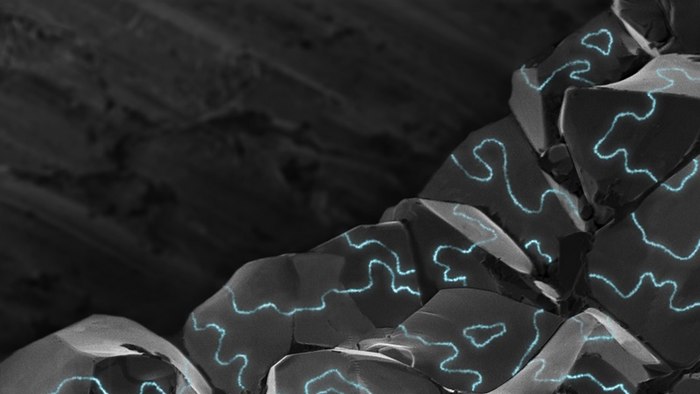Material that could revolutionize memory storage is magnetic, but not as we know it
- Colin Jeffrey
- November 2, 2015

Conducting along the boundaries of individual grains, a normally non-conducting material may one day provide superior magnetic memory devices (Credit: Eric Yue Ma/Stanford University)
Using a type of magnetic insulator material that normally doesnít conduct electricity, scientists working at Stanford University and the Department of Energyís SLAC National Accelerator Laboratory have shown that electric currents can still be made to flow along the borders of the grains within the material. This latest research not only validates a long-held belief that magnetic insulators could be used to conduct electricity, but offers a more tantalizing possibility of creating highly-efficient magnetic memory devices.
"This physics is interesting and had been thought to exist, but it
remained elusive for the last 60 years," says Zhi-Xun Shen, the SLAC and
Stanford professor who led the research. "Now itís been seen directly in
this experiment."
The material being researched is a recently-developed amalgam of neodymium, iridium and oxygen (ND2Ir2O7). Synthesized in the laboratories of the University of Tokyo and the RIKEN research institution in Japan, the substance is technically a magnetic material, when viewed in the conventional sense, as it has large numbers of un-paired electrons stacked in an array that would normally give the material an overall magnetism.
However, unlike recent experiments that
created magnetic materials from non-magnetic ones, the molecular
make up of this new material renders it non-magnetic by having the
neodymium's influence effectively cancelled out by the other ingredients
in the mix. Whilst this may sound somewhat counterintuitive, it simply
means that scientists can take advantage of the materialís unusual
molecular structure to observe various and unusual electron behaviors
not possible in more conventional substances.
Also unable to conduct electricity in any conventional way, the latest research has shown that the materialís unusual mixture provides conduction paths via the magnetic domains that exist along the boundaries of its constituent grains. At certain temperatures and with the application of microwave energy, these regions form snaking, continuous paths for the movement of electrical current. Also able to be switched from conducting to insulating by altering the temperature applied, this phenomenon holds hope for highly-efficient magnetic memory applications.
"This can provide a more straightforward way to use magnetic material as memory," says Eric Yue Ma, a graduate student in the laboratory of Zhi-Xun Shen. "Today you need to convert magnetic information into electrical information when reading magnetic memory, usually via multiple layers of different materials. But if you have both types of information within the material itself, you can skip that step."
To observe the switchable conductive behaviour of the material, the Stanford team incorporated what is known as Microwave Impedance Microscopy, or MIM. This method involves injecting microwave energy directly to the substance via a very fine probe and measuring the strength of that energy on its return journey. Capable of testing areas as small as just 100 nanometers, this process also allows the researchers to measure the electrical resistance of the material.
Though the material being researched is only able to demonstrate this domain boundary conductivity at exceptionally low temperatures (around 4.7 K (-268.45 ļC or -451.21 ļF)), and so far only at the tested frequencies (approximately one Gigahertz) the SLAC team is quick to point out that other researchers have just recently described comparable behavior in a similar material that may work at higher temperatures of around - 45 ļF (- 42 ļC).
"Itís a beautiful experimental technique, to be able to make these measurements, and the technique could be applied to a huge range of materials. Itís remarkable how large the magnetic domains are. Thatís great news; it means we can isolate a single domain and measure its properties," says Leon Balents, a professor of physics at the University of California, Santa Barbara (who wasn't actually involved in the study). "And now that they have a handle on being able to locate the domains, they can use those techniques to attack further questions. While this is a fundamental physics study, in the long term people are thinking toward many different types of applications."
The researchers also suggest that altering the organization of the magnetic domains in the material may offer unique ways to store information. That is, they believe, by changing the amount of domains present in a narrow area by heating or bending the material, for example, the insulating or conductive properties could be significantly altered at will. As such, these two opposite states could be taken as ones and zeroes and applied to the storage and retrieval of binary information.
According to the scientists, such memory devices could be more inherently stable than current FLASH memory, and may be able to be created at physical dimensions far smaller than those possible today.
The results of this research were recently published in the journal Science.
Source: SLAC
http://www.gizmag.com/magnetic-insulator-memory-storage-slac/40166/


